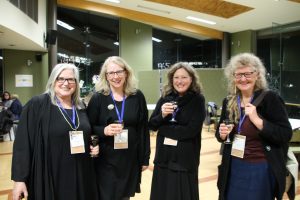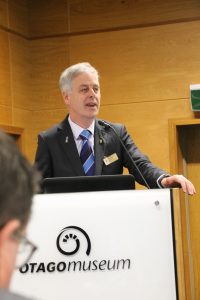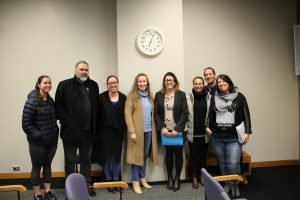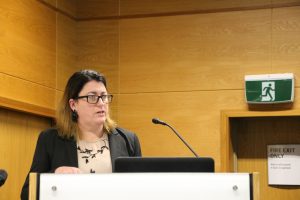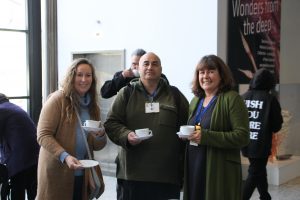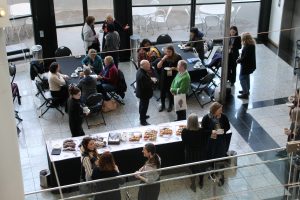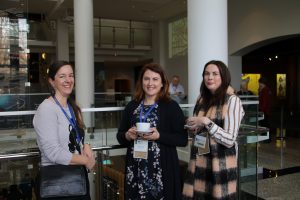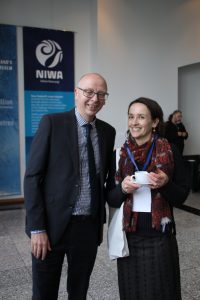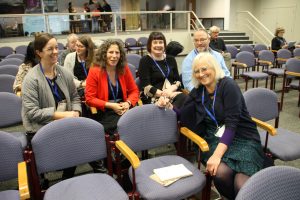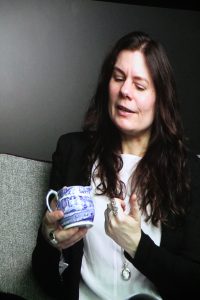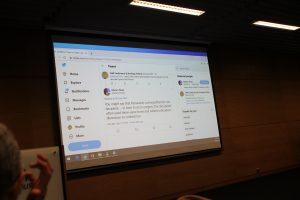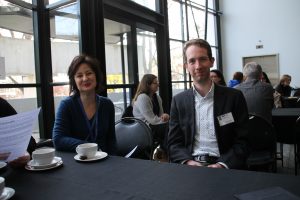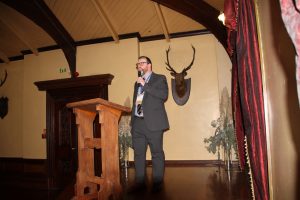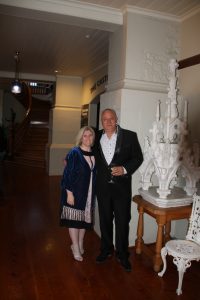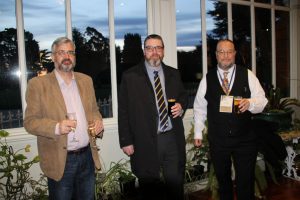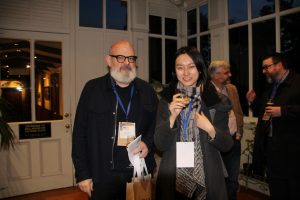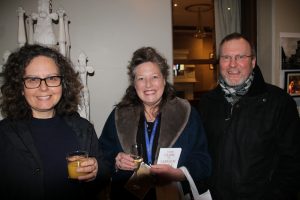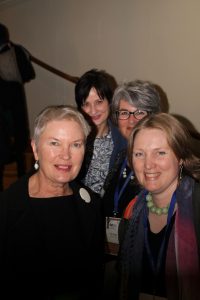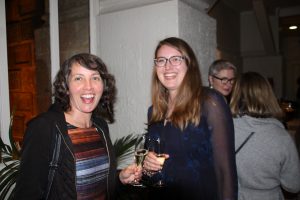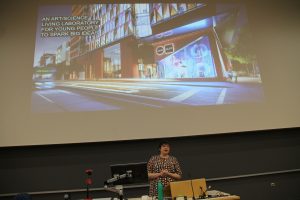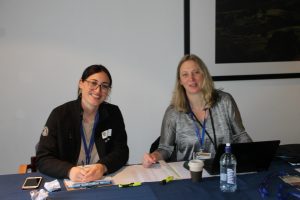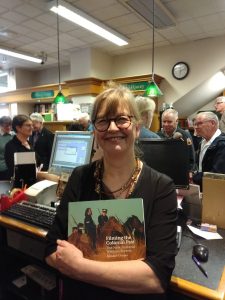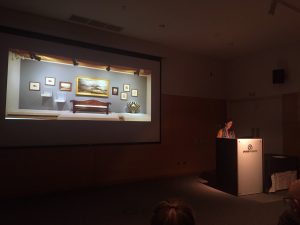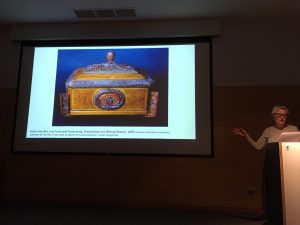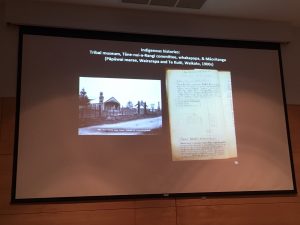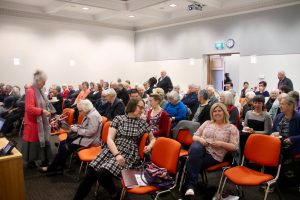Marsden success for Kate Stevens
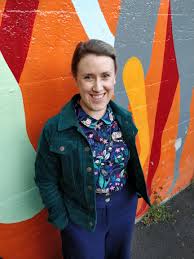 The Centre is really happy for the Marsden success of one of our associate members, Dr Kate Stevens, now based in the History programme at the University of Waikato. Her project, Urban island: Histories of dispossession and belonging in Suva, gained a Fast Start Marsden award in the 2020 round.
The Centre is really happy for the Marsden success of one of our associate members, Dr Kate Stevens, now based in the History programme at the University of Waikato. Her project, Urban island: Histories of dispossession and belonging in Suva, gained a Fast Start Marsden award in the 2020 round.
Kate is a former History student at Otago, who completed her PhD at Cambridge University in 2015, on colonial criminal justice in New Caledonia, Fiji and Vanuatu, then undertaking a postdoc back at Otago with Professor Judy Bennett’s project on the history of coconuts.
This has been a great year for Kate! As well as her Marsden, she won a teaching excellence award at Waikato, and a Camargo Fellowship. Each year, the Carmago Foundation Core Program brings 18 artists, thinkers, and scholars for residential scholarships in Cassis, France as part of its mission to support research in the Arts and Humanities. Kate will be joining the spring 2021 cohort (travel restrictions permitting) for 11 weeks to work on a new project examining the history of smell in the French colonial empire, and its legacies in contemporary products, tourism, and ideas of place. You can read more about Kate’s research on her website.
Congratulations, Kate!
The amazing “1869” conference
Otago hosted a brilliant hybrid conference this week, the “1869 Conference and Heritage Festival”. By “hybrid” I mean that it was the annual conference for the Australasian Victorian Studies Association, while also celebrating the University of Otago’s 150th anniversary, and sitting alongside the Dunedin Heritage Festival. While the Centre for Colonial Culture was a key sponsor, with Associate Professor Angela Wanhalla as one of the co-convevors (together with Kirby Hallum), a cross section of the university’s faculty was represented on the organising committee. The melange meant that most people engaged with papers that they would normally never encounter at their more usual disciplinary conferences, although this added to, rather than diminished, the event’s success. [See below for photos]
On Wednesday evening, the conference began with an all-women panel, looking at “Heritage through Words, Pictures and Threads”. Chaired by Kirby, the panel featured the novelist and academic, Tina Makereti, who discussed her latest novel, The Imaginary Lives of James Poneke; Lisa Chatfield, the producer for the BBC television adaptation of The Luminaries; Madeleine Seys, author of Fashion and Narrative in Victorian Popular Literature; and Otago’s Catherine Smith, an expert behind the science of traditional Māori weaving. This was a wonderful collaboration, exciting for those interested in the sumptuous garments of the Victorian era, but also drawing a number of different “threads” together. This was followed by a reception held in Te Tumu: School of Māori, Pacific and Indigenous Studies.
1869 was formally opened in the Otago Museum on Thursday (26 September) with a mihi whakatau from Tuari Pōtiki representing both Kāi Tahu and the university, a short welcome from the DVC Research, Professor Richard Blaikie, and an amusing and uplifting speech from the Hon Grant Robertson, an Otago alumnus as well as the current (among other portfolios) Minister for Arts, Culture and Heritage. The PVC Humanities, Professor Tony Ballantyne then introduced the first keynote speaker, Megan Pōtiki of Te Tumu, who discussed how the school established in 1869 contributed to the demise of the speaking of te reo Māori at Ōtākou, just under 30 minutes drive from the city. However, in more recent years the concerted efforts of local people have seen the revival in the language at the kāik.
There are too many individual presentations to mention them all. Most were what one might expect at a history or literature conferences, but also sprinkled with a few science-orientated talks as well. Several stand out, such as the presentation by Dr Ian Chapman on the links between Jules Verne’s From the Earth to the Moon with David Bowie’s Space Oddity – including a live band!; Lyndon Fraser’s swirling PowerPoint while discussing women’s wills in Victorian Canterbury; and Lyall Hanton’s physically animated talk on Joseph Mellor’s 16 million words on the Periodic Table. But the organisers were gratified at the high quality of all the panel presentations.
The conference highlights, of course, were the keynotes. On Thursday evening, people braved a dismal night to listen to Helen Pearson, editor of Nature, a journal that shares a 150th birthday with the university. Helen gave a wonderful talk on the past, present and future of this illustrious journal, noted not just for its academic papers but the science reporting and commentary. The “past” incorporated some of the journal’s many key publications, such as Francis Crick and James Watson’s groundbreaking paper on DNA in 1929, as well as a notable failure, an account on cold fusion. Helen also discussed Nature’s current situation, and how that may change with the growing demand for open-access publications.
Marian Thain, of Kings College London, was unable to make it to Dunedin for the conference, but nevertheless presented on“Cosmopolitanism, Nationalism and the Politics of Parnassian Poetry (1860s-1880s)” on Friday. An exploration of how English poets adapted the ballade, a French poetry genre, the talk discussed how the Parnassian poets’ efforts spawned tensions between those who favoured a more international outlook and those who advocated for more British forms of verse. Marion pre-recorded her video presentation, and invited questions via Twitter both during and after its viewing, which worked really successfully. Indeed, the conference goers included a number of enthusiastic tweeps, with the conference at one point trending up to 5th place in New Zealand’s Twitter rankings. See #otago1869 and #avsa2019.
Conference goers were treated on Friday evening to a bus trip up to the historic Larnarch’s Castle atop the Otago Peninsula. On arrival, just before dusk, the swirl of bagpipes greeted us as we alighted the buses and entered the castle. After newcomers had undertaken a tour of the building and we had all had the opportunity to wet the whistle, we all entered into the banquet hall for a marvellous feast. The “entertainment” for the evening was Professor Liam McIlvanney, who gave a wonderful speech arguing that Rev Thomas Burns, the nephew of the great poet, the first clergyman of Dunedin’s Free Kirk settlement, and first Chancellor of the University, was perhaps not the “censorious old bigot” that secularist historians have labelled him.
Tilly Boleyn, the Curator of Science Gallery Melbourne, was our final keynote to round off the conference. Tilly discussed how hard it was to entice young people (18-25 year olds) into science museums, which are seen as boring and irrelevant. The answer has been to establish “science galleries”, and international network tied to local universities, but whose “displays” are about engaging the public with science and art. Melbourne’s science gallery opens next year, but in the meantime they have run a number of “pop-ups” to prepare the ground. An important feature of this new style of institution has been to allow young people themselves to decide what will be presented, and to employ young people to “moderate” the exhibits with the gallery visitors. This new methodology means curators giving up power, which Tilly states, is both challenging and rewarding.
At the final wrap-up, the AVSA president Mandy Treagus announced that the next AVSA conference will be held in Melbourne at Monash University in June, 2020.
And another viewpoint from the Women Historians Blog.

The first evening. Kirby-Jane Hallum, Madeleine Seys, Catherine Smith, Lisa Chatfield and Tina Makereti.
Call for applications: PhD on Māori Literature and the News
There is an exciting opportunity for someone to do a PhD on “Māori Literature and the news”, as part of a Marsden project headed by Associate Professor Jacob Edmund (English and Linguistics, University of Otago). A Masters or BA(Hons) in Māori Studies, English, History, Media Studies or a related field would be preferred.
See: PhD scholarship in Māori literature and the news for details.
Please circulate this on your own networks, or forward to anyone you think might be interested.
CROCC member makes Ockham long list
Congratulations to CROCC member Annabel Cooper. Her book, Filming the Colonial Past: The New Zealand Wars on Screen (Otago University Press), has been placed on the long list for the 2019 Ockham Book Awards, New Zealand’s foremost book awards. Click here for more information on this outstanding book.
Curiosity in Things
CROCC’s first event for 2019 concluded successfully on Friday 25 January. Dr Rosi Crane, a graduate of Otago History’s PhD programme, an Associate Member of the Centre, and the Museum’s honorary curator of science history organised ‘Held in Trust: Curiosity in Things’, a conference, held at, and in conjunction with the Otago Museum which commemorated its 150th anniversary last year. A range of people, both academics and heritage sector professionals, attended and presented, with most topics relating to collections, collecting and practice in museums from the colonial-era to the present. See also Otago Humanities story about the conference.
Tony Ballantyne (University of Otago) provided the first keynote, ‘Cultures of Collecting in Colonial Otago’ on Thursday morning. He noted that notions of “improvement” stimulated the development of intellectual life and culture in early Otago. Several points resonated through many of the following talks: that local enthusiasm, activity and donations allowed institutions such as museums, and even New Zealand’s first university, to be founded and developed; that collecting pervades colonial culture; and that scholars should always be cognizant of the interplay between words and objects. Tony’s talk highlighted the work of Herries Beattie, a local historian who recorded extensive mātauraka from Southern Māori, but was also an inveterate collector of texts and things, with his collections now housed at the Hocken, Otago Museum, as well as museums in Gore and Waimate. See ODT story.
In ‘“My dear Hooker”: the botanical landscape in colonial New Zealand’, Rebecca Rice (Te Papa) explored the New Zealand “flower painting” of Georgina Hetley and Sarah Featon in the late nineteenth century, whose botanical work was popular but largely unsupported by the scientific world overseen by the likes of Sir James Hector in New Zealand, and Sir Joseph Hooker in the UK. Rebecca’s paper stressed the need to acknowledge women’s contribution to science in New Zealand.
Linda Tyler (University of Auckland) looked at the John Buchanan, who worked with Hector at the Colonial Museum, his botanical draughtsmanship and his extensive (if poorly labelled) collections of botanical specimens. Indeed the sending of material to the UK assisted in Buchanan’s ambitions to be recognised as a botanist of note.
It was the practice of medical schools to create collections students could learn from; Otago, which established its first Chair of Physiology and Anatomy in 1874 is no exception. Chris Smith (University of Otago) gave a fascinating account of the collections of Otago’s Anatomy Museum, its many specimens of flesh, organs and bones, and models constructed from plaster, wax or papier mache. Early professors, interested in racial difference, sent their medical students out to scour burial sites and other places for Māori human remains; the Museum’s koiwi Māori collection is now in the process of being returned to local iwi.
Justine Olsen (Te Papa) discussed the cabinetmaking objects produced by Anton Seuffert and Johann Levien from the 1850 to the 1880s. Their high-quality pieces featured in international and colonial expositions as examples of New Zealand craftsmanship while showing off the various New Zealand woods. Seuffert collaborated with the carver Ferdinand Teutenberg to produce items sought-after by New Zealand’s elite. Featuring designs influenced by Ferdinand Hochstetter, their work points to New Zealand’s German network of the late nineteenth century.
The first day was brought to a close with the keynote of Simon Ville (University of Wollongong), ‘The exchange, finance and logistics of natural history: a global trade like no other?’ Simon is part of an inter-disciplinary team focussing on the collection practices in the nineteenth century of the MacLeay Museum and the Australian Museum. The accumulation of dead creatures (or parts of them), involved purchases from collectors and trading firms, exchanges between institutions, financing field collections, or donations, all of which could be problematic. He argued that the commerce in “natural history” does not appear to adhere to the ideal conditions for trade and exchange, but despite its difficulties still managed to survive.
David Gaimster (Auckland War Memorial Museum) began the second day with ‘Fitting the colonial museum dashboard? Curatorial agency, civic action and identity building at the Auckland Museum (1852-1917)’ on the early days of the institution that he is responsible for. David explored the synergies of civic action of local Aucklanders to found their museum with the imperial networks that enabled it, and how the “successive intentions” of curators shaped its practice and exhibitions. In particular, serious scientific enquiry and disciplinary presentations sat at the edge of the museum’s other aim, to amuse or educate the wider public. More so than some other countries, New Zealand museums collected artefacts from its indigenous people, a process that Māori themselves, in some part, were able to control.
Rosi Crane (CRoCC, Otago Museum) turned to the work of the first three curators of the Otago Museum with ‘What were they thinking? Tracing the traces of scientific thought through the Museum collections (1868-1939)’. Unlike other museums, the Otago Museum was part of the university, with the early curators, Frederick Hutton, Thomas Jeffery Parker and William Benham mixing academic teaching roles with building and maintaining their collections. Rosi traced their scientific interests, as the museum expanded. All three were ardent evolutionists, but felt compelled at times not to advertise the fact in their museum displays.
Most of the conference attendees were probably unaware of the influence of Korean art in New Zealand ceramics. While Chinese and Japanese ceramics are often seen as pioneering, Korean art is just as significant, and the three nations influenced each other over many centuries. Grace Lai (Auckland War Memorial Museum), in ‘Inequality of knowledge: reinvestigating the influences of Auckland Studio Pottery through the lens of Korean ceramics’, discussed the extensive collection of Korean pottery held by the Auckland Museum, and how, after the opening of the Hall of Asian Arts in 1969, this influenced Auckland’s potters.
The burning bush (Exodus 3) has been an enduring symbol for Scottish Presbyterianism from the 1600s, and was subsequently exported to New Zealand with the Free Church migrants in 1848. Steve Taylor (Knox Centre for Ministry and Leadership) explored this theme in ‘The symbol of the burning bush as an object in global exchange and local adaptation’. The image appears in books and bookmarks, and has even in flower beds, and portrayed through the Scottish saltire forms the New Zealand church’s current logo. Steve elaborated on how the Scottish symbol had been reframed and transformed through culture, such as in the blue, frangipani-graced burning bush stained glass window at St Johns Papatoetoe, reflecting the churches links to the Pacific Ocean and its peoples, and the stylized “glowing vine” of Te Aka Puaho, the Māori Presbyterian Synod.
Kane Fleury (Otago Museum) expounded on the Museum’s extensive Lepidoptera collection in ‘Books and drawers full of moths’, much of it the work of the still-living collector, Brian Patrick. The museum has been involved in several collaborate moth-related projects: Mothnet, “citizen science” working with school children to collect and report on the moth populations, and the production of guides of New Zealand moths both in English and te reo Māori and the digitisation of the Museum’s extensive moth collections. By comparing the notes and collection data of historic moth collection with more current data, the Museum is helping to understand how environmental change is affecting our rich moth fauna.
The mauri of places and resources were often embodied in kōhatu (stones) that maintained and safeguarded their wellbeing. This, of course has implications for museums that hold such taoka, but that might also produce their own embodiments of mauri. Rachel Wesley (Otago Museum) explored this kaupapa in ‘Kōhatu Mauri: an exercise in practice across cultures’, discussing how the Museum had created its own kōhatu mauri from within its collections. Unlike traditional iterations, whose tapu might preclude physical contact, the modern kōhatu are placed to be touched by museum visitors. Rachel explored the implications of this, and the conflicting values and preservation practices of the museum and mātauraka Māori, and how an accessioned item that ordinarily is only for viewing might be recontextualised (and de-accessioned), changing from mere geological artefact to a taoka with new meanings.
Conal McCarthy (Victoria University of Wellington) was given the hard task in his keynote, ‘From curio to taonga: 150 years of museum histories, theories and politics’ to wrap up the conference, of drawing in the preceding talks, while also giving his take on New Zealand’s museums’ own pasts, presents and futures. Conal, acknowledging that museums were part of a wider colonial culture, looked at how museums had interacted with tāngata whenua and their culture, again stressing that Māori had often been involved in how Māori material might be exhibited. He also noted that Māori had sometimes had their own museums, such as the Kotahitanga base at Papawai, and that individuals such as Ngata and Buck through their involvement with ethnology, museums and heritage, had been prominent in how Māori culture might be seen. But New Zealand had now come to a time when museums needed to find new ways to engage with indigenous peoples, in particular through employing whakapapa as a practical ontology for the future.
The conference had a great buzz, with the single-stream format, a diversity of topics, and the generous coffee breaks allowing the sixty-odd people who attended to engage in many fruitful exchanges. Many congratulations to the organiser, Rosi Crane, on hosting such a fun and productive conference. She is now investigating how some of these presentations may be converted into published research outputs.
New Publication on Indigenous Mobilities
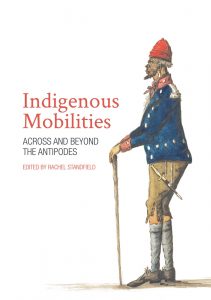 In November 2014, CROCC co-hosted the Indigenous Mobilities symposium at Otākou Marae. This event attracted a number of Australian historians as well as some CROCC scholars, looking at Māori and Aboriginal mobilities of the past. ANU Press, in conjunction with Aboriginal History, have published this research as Indigenous Mobilities: Across and Beyond the Antipodes. This edited collection can now be downloaded free in PDF or eBook form either in its entirety or as individual essays, including those of CROCC members, Tony Ballantyne, Angela Wanhalla and Lachy Paterson.
In November 2014, CROCC co-hosted the Indigenous Mobilities symposium at Otākou Marae. This event attracted a number of Australian historians as well as some CROCC scholars, looking at Māori and Aboriginal mobilities of the past. ANU Press, in conjunction with Aboriginal History, have published this research as Indigenous Mobilities: Across and Beyond the Antipodes. This edited collection can now be downloaded free in PDF or eBook form either in its entirety or as individual essays, including those of CROCC members, Tony Ballantyne, Angela Wanhalla and Lachy Paterson.
Angela Wanhalla keynote speaker at Law & History Conference
The next Australia and New Zealand Law and History Society conference is meeting at the University of Wollongong in December hosted by that university’s Centre for Colonial and Settler Studies. Its theme is “Exclusion, Confinement, Dispossession: Uneven Citizenship and Spaces of Sovereignty”, with the call for papers closing on 20 July. It’s great news that Angela Wanhalla, CROCC co-director, will be a keynote speaker at this conference, drawing on her Rutherford Fellowship research on marriage in conjunction with the conference themes.
“Redcoat and Rifle” at Toitū
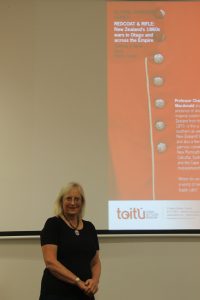 Professor Charlotte Macdonald from Victoria University drew a large crowd to the Centre’s second Global Dunedin lecture at Toitū Settlers Museum today. Charlotte brought Dunedin into the larger picture of the global circulation of soldiers and their belongings that stretched between Britain, India and the rest of the Empire. Her wide-ranging talk included the 70th Regiment who were transferred from India (where they had fought during the Indian Rebellion) to Auckland in 1861. While some stayed in the North Island and fought in the Waikato campaign, one contingent was transferred to Dunedin where they established themselves on what eventually became the Arthur St School. Soon after gold had been discovered in Central Otago, the contingent helped keep the peace and good order until they left in 1863. Charlotte’s research comes out of her Marsden-funded project, Soliders of Empire: Garrison and Empire in the 19th Century. The talk was followed by a lively question time. Many thanks to Charlotte for her rich and engaging lecture.
Professor Charlotte Macdonald from Victoria University drew a large crowd to the Centre’s second Global Dunedin lecture at Toitū Settlers Museum today. Charlotte brought Dunedin into the larger picture of the global circulation of soldiers and their belongings that stretched between Britain, India and the rest of the Empire. Her wide-ranging talk included the 70th Regiment who were transferred from India (where they had fought during the Indian Rebellion) to Auckland in 1861. While some stayed in the North Island and fought in the Waikato campaign, one contingent was transferred to Dunedin where they established themselves on what eventually became the Arthur St School. Soon after gold had been discovered in Central Otago, the contingent helped keep the peace and good order until they left in 1863. Charlotte’s research comes out of her Marsden-funded project, Soliders of Empire: Garrison and Empire in the 19th Century. The talk was followed by a lively question time. Many thanks to Charlotte for her rich and engaging lecture.
Successful Start to Global Dunedin
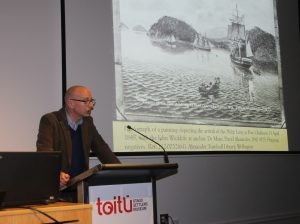 The first Global Dunedin programme at Toitū Otago Settlers Museum began with Centre Co-Director, Professor Tony Ballantyne, presenting on “The John Wickliffe, the Philip Laing and the Making of the Otago Colony”. Tony’s lecture was wide-ranging, taking us from the initial landing of the Free Church settlers, and their interactions with Kāi Tahu, right through to the 50th anniversary, where the the debate centred on who truly deserved to be included into the category of “early” settler.
The first Global Dunedin programme at Toitū Otago Settlers Museum began with Centre Co-Director, Professor Tony Ballantyne, presenting on “The John Wickliffe, the Philip Laing and the Making of the Otago Colony”. Tony’s lecture was wide-ranging, taking us from the initial landing of the Free Church settlers, and their interactions with Kāi Tahu, right through to the 50th anniversary, where the the debate centred on who truly deserved to be included into the category of “early” settler.
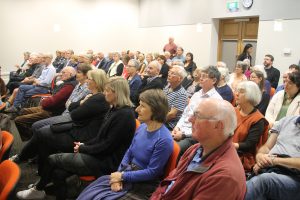 The Centre’s Global Otago programme brings engaging speakers to Toitū, who can place Dunedin in a global context, whether in the past, present or future. This lecture was a resounding success, with more seats having to be brought in to accommodate the crowd. Professor Charlotte Macdonald will be delivering the April lecture; details will be posted soon.
The Centre’s Global Otago programme brings engaging speakers to Toitū, who can place Dunedin in a global context, whether in the past, present or future. This lecture was a resounding success, with more seats having to be brought in to accommodate the crowd. Professor Charlotte Macdonald will be delivering the April lecture; details will be posted soon.
Public and Popular History
The Centre was pleased to host Tanya Evans of Macquarie University who gave a public lecture last week. While this was Tanya’s first trip to New Zealand, we also welcomed back a more regular visitor from Australia, Kristyn Harman (University of Tasmania) accompanied by her partner, Nick Brodie.
Academics are encouraged to make their research more “impactful”, which for Humanities scholars is often to get their research out beyond the narrow academic enclaves we work in. Presentations from all of three of the visitors above were relevant to this theme. Tanya, Director of Macquarie’s Research Centre for Applied History, discussed ‘The Emotions of Family History’, looking at why family historians and genealogists undertake their research, and how such research informs wider community understanding of, and individuals’ emotional connection to the past. In her investigations, Tanya interacts with family historians, with her research having far more impact than that of more siloed academic history.
Kristyn was in Dunedin to launch her new book, Cleansing the Colony: Transporting Convicts from New Zealand to Van Diemen’s Land (published by Otago University Press) which examines the more than 100 people sent from New Zealand into the Australian penal institutions. Kristyn also gave a lecture on these convicts to the Tuesday Club at Toitū: Otago Settlers Museum last week. Although most of the Club are retired and from many walks of life, they were keen, attentive, and intellectually engaged, with Kristyn’s talk attracting their largest crowd of the year.
Nick Brodie is an established Australian popular historian, author of Kin, 1787, and The Vandemonian War. Although he has his own academic background in history and archaeology, he now reaches a much larger market through well-researched but accessible books. Nick shared his own publishing experiences in a seminar to both staff and postgraduates at the university, with tips on how to make history relevant and engaging for non-academic audiences.

